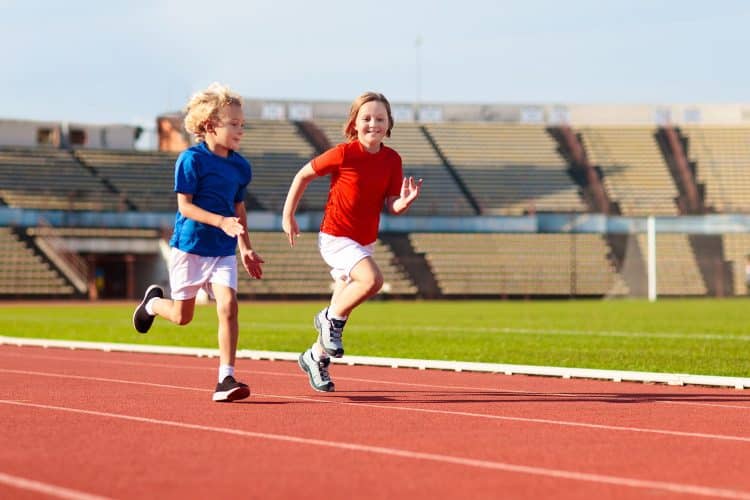
Playing sports is great for the physical and psychological benefits doing so can generate for youth athletes, such as physical coordination, fitness, self-esteem, teamwork, and self-discipline. However, youth athletes are at a higher risk for developing sports injuries due to their bodies still growing and developing. There are also significant differences in coordination, strength, and stamina between children and ages, which can make managing some teams more challenging.
Most sports injuries in young athletes happen due to lack of education and awareness of safety, inappropriate equipment or lack of proper gear, or poor conditioning. Their growing bones, muscles, tendons, and ligaments make them more susceptible to injury. However, there are several things you can do as a parent and/or coach to help young athletes be successful and stay safe.
Our physical therapy experts at the NPTIFL put together a list of considerations to keep in mind. Read on to learn our top eight recommendations for ensuring the health and safety of youth athletes.
1. Ensure Youth Athlete Is Physically and Psychologically Ready For Sports
Knowing whether a child is ready to play sports depends on the individual child, not just their size or age. While you should take into consideration their age, weight, and build, you should also weigh their physical and emotional development. For example, they should be able to understand the rules of the game, the importance of teamwork, and the commitment playing a sport requires.
Commitment is also a reason you may want to wait for your child to express interest in the sport prior to helping them join a team. You’ll want to prepare the child for the demands of playing a sport, such as the importance of practicing, wearing equipment properly, and following the rules.
Finally, take caution with contact sports until the athlete’s body has developmentally caught up to their peers to help avoid injury.
2. Get A Sports Physical Each Year
An annual sports physical is actually required by many schools in order for an athlete to participate in sports. Regardless, important to get to ensure your child is physically fit enough to play in a certain sport. This exam can reveal physical strengths and weaknesses that can help determine which sports (if any) are appropriate for their age. It also gives both parents and children the opportunity to touch base with the doctor on their overall health and wellness.
3. Have The Right Safety Gear and Equipment
This is critical to ensure the health and safety of youth athletes. Gear and equipment will be sport-specific, like pads, mouth guards, shin guards, helmets, goggles, or others. It’s important that each athlete has the gear required and that it fits properly.
It’s also important that other sports equipment like nets, baskets, balls, etc. are in good working condition, or are replaced if not. Playing areas should be free of debris, standing water, or other dangers, and regularly maintained as appropriate for the sport.
4. Always Warm Up and Cool Down
Youth athletes should get at least 15-20 minutes of time before and after every practice and game to warm up and cool down properly. This should include both dynamic and static stretching and light activity, like jogging. Warming up and cooling down properly can help release muscle tension and prevent injury.
5. Teach Importance of Nutrition and Hydration
Staying hydrated ensures the athlete is replacing water lost through sweat. This is essential for thermoregulation and preventing cramps, heat exhaustion, and heat stroke. Have the athletes drink fluids before, during and after each practice or game – about eight ounces every 15 to 20 minutes. Also try to discourage caffeine and carbonated beverage consumption.
Be aware of symptoms of dehydration, including extreme thirst, weakness, headache or dizziness, dark-colored urine, or slight weight loss.
Additionally, a balanced nutritional diet is important to have energy needed for playing sports. The youth athletes are more likely to be tired or perform poorly when they don’t get proper nutrition. Plus, a balanced diet can:
- Help with injury prevention
- Decrease muscle tiredness and soreness
- Promote healing and recovery
- Support a healthy immune system
Be sure to help them maximize healthy carbohydrate and protein intake.
6. Encourage Proper Conditioning
Conditioning should be age-appropriate and doesn’t have to mean running mile after mile. However, being in proper shape and conditioned can help reduce the risk of injury and keep the athletes healthy. Conditioning can be (but is not limited to):
- Weight training
- Strength training
- Plyometric exercise
- Sprinting intervals
- Compound movements
The primary purpose is to improve strength, flexibility, balance, coordination, speed, agility, and endurance, but all of this will help prevent injury in youth athletes. Be sure to condition during the off-season to avoid getting too much out of shape.
7. Know Common Injuries and How To Treat Them
The most common sports injuries in youth athletes include:
- Acute injuries, like:
- Broken bones
- Sprains
- Strains
- Cuts or bruises
- Overuse injuries, such as:
- Achilles tendinitis
- Knee pain
- Shin splits
- Stress fractures
- Throwing injuries in shoulder or elbow
- Concussions
Most injuries, especially concussions, should be evaluated by a doctor. For most acute injuries, treatment provided right when the injury occurs includes:
- Rest
- Ice (20 minutes at a time)
- Compression (lightly)
- Elevation (higher than the heart)
8. Make Rest A Priority
This can be difficult, but it’s important. Proper rest can help avoid overuse injuries as well as burnout, which is common as youth athletes age. It’s especially important for any pain, injury, or illness the athlete is experiencing. Aim for at least one to two days off each week.
Contact the National Personal Training Institute of Florida
If you would like to become a personal trainer in Orlando, Tampa, or the surrounding areas, contact the National Personal Training Institute of Florida. We can help you accomplish your goals and embark on a rewarding new career. Call (813) 374-2017.
Tags: Young Athletes, Youth Athletes
